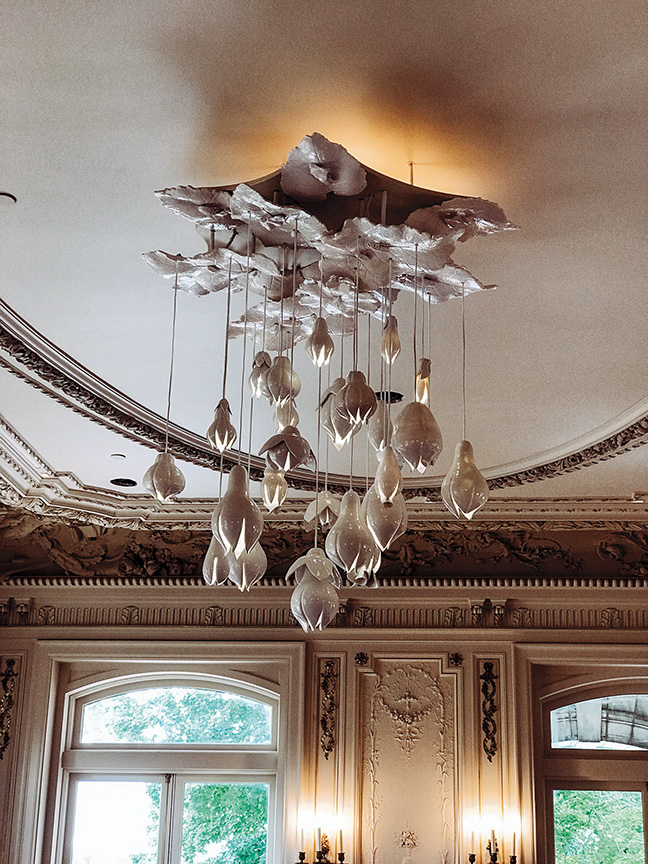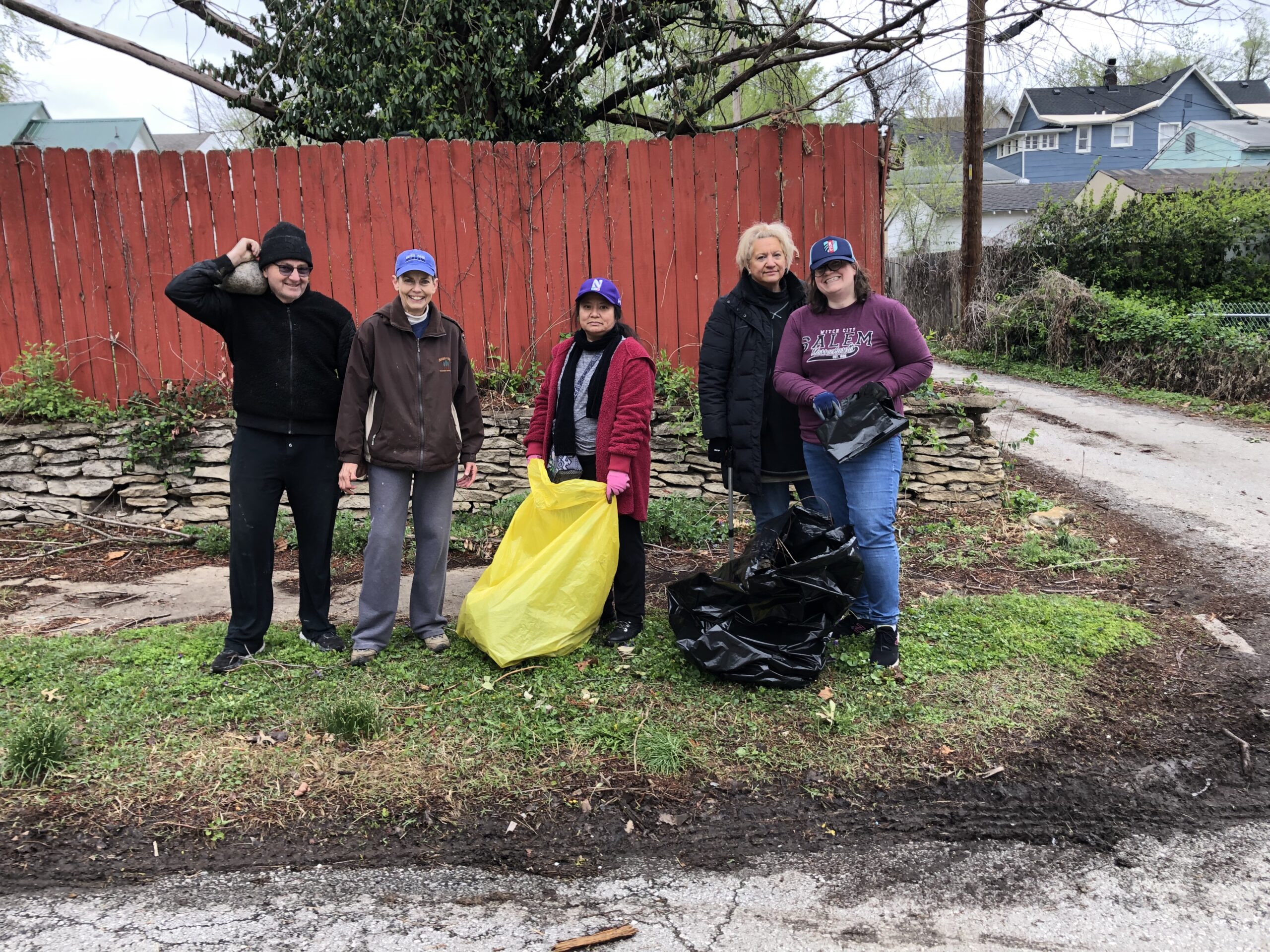
Abby Hoover
Managing Editor
Corinthian Hall, home of the Kansas City Museum, is adjusting to major structural changes as the exhibits are being finalized and design details are ironed out.
The mansion at 3218 Gladstone Blvd. has been closed since 2017 to undergo a $20 million renovation and restoration project. The 70-room mansion itself is an artifact, built in 1910 by lumber baron Robert Alexander (R.A.) Long in the Beaux-Arts style.
Earlier this month, Executive Director Anna Marie Tutera and Programs Director Paul Gutierrez met with team members to finalize fabrics and furniture throughout the museum. With careful consideration, they compared swatches and undoubtedly considered the visitors who would use them for years to come.
At an auction in 1934, many original pieces of the house were sold off, never to be seen again. A statue, one of the few items that was returned, stands wrapped in a white sheet in the Grand Hall, waiting to return to its original position.
Thoughtful design illuminates decades-old craftsmanship and original woodwork. Where original elements are missing, or were deteriorated beyond repair, modern fixtures blend harmoniously into the rooms.
“You’ll see starting on the first floor, we really worked hard to integrate a contemporary design and feel into the historic aesthetic,” Tutera said. “We tried really hard to make sure that that integration was very seamless and didn’t jeopardize the integrity of what remained historically or what we decided to recreate.”
Lighting is a prominent feature for the museum, being used both to enhance displays and as decoration. Additionally, building onto the infrastructure by adding fire suppression, modernizing the HVAC and regulating temperature and humidity were challenging.
The building took time to acclimate to all the structural changes, Tutera said, but it was ultimately successful.
Visitors will enter through the front of the house, which is now Americans with Disabilities Act (ADA) compliant, into the Grand Hall, which boasts a marble staircase lit by an intricate stained glass window.
The first floor exhibits will explore the history, legacy and impact of the Long family, along with the architectural history of the museum. It will also be home to a cafe and retail store.
A modern cafe will utilize seating in the original breakfast room, but will also provide a space for culinary programs and cooking classes. The sun parlor will serve as a gift shop for the museum.
On the main floor, exhibits will be strategically planned, with casework and displays taking up about 20% of the floor space in each room, leaving plenty of room for programs and events.
COVID-19 has had them rethinking everything from interactive touch screen displays to programming, capacity and digital platforms.
Traditional gallery space will occupy the second and third floors. The second floor, which was originally where the family slept, will have five main exhibit galleries, a classroom and meeting space. Four of the galleries will take visitors through a chronological timeline of Kansas City’s history: 1870s, 1880s to 1920s, 1910 to 1940s and 1940s to 1980s.
The fifth second-floor gallery will feature limited-run exhibits, changed annually, that will take a deeper dive into the museum’s extensive collections.
A driving factor in the curation of these new exhibits is counter-narrative, telling the complete story of the objects that will be displayed and Kansas City, which will be expanded through events, programming and curriculum for visiting students.
The Kansas City Museum’s collection contains more than 100,000 objects, including an archive of film, photographs, manuscripts and ephemera; the Dyer Native American collection of cultural and historic objects; a large clothing, accessories and textiles collection; a fine arts collection of paintings of local subjects; a transportation collection including rail cars and carriages; a collection of firefighting objects from the Kansas City Fire Historical Society; decorative art including some original furnishings from Corinthian Hall; and they’re still collecting.
The third floor of Corinthian Hall, formerly staff quarters, will have three main exhibit galleries; a theater, which used to house the famous igloo; and a story sharing place that will be used to experience oral histories.
An interactive story sharing place will allow visitors to experience oral histories of many Kansas Citians with different backgrounds: Chinese, Japanese, Croatian, Muslim, Indian, Indonesian, Mexican-American, Somali, transgender, Loatian, Greek, Downs Syndrome, Vietnamese, Cuban, Thai and Philipino, just to name a few.
“Eventually here, the goal will be to have people come record their stories, they leave that behind, but when we reopen we’ll have 20 to 21 profiles of people in Kansas City,” Gutierrez said. The hope is that these stories will lead to programs, events, culinary classes and performances. Gutierrez said the Kansas City Museum could act as the entry point for visitors to get an introduction to Kansas City before diving into the neighborhoods and other museums like the American Jazz Museum or the Nelson-Atkins Museum of Art.
The museum is working with the UMKC Center for Neighborhoods to highlight the history of different areas of Kansas City with contributions from neighborhood leaders.
On the lower floor of Corinthian Hall, visitors will be able to quench their thirst at a soda fountain, just down the hall from the billiards room.
Though the vendors for the soda fountain and cafe have not yet been selected, they will bring more jobs to the museum and nourishment to visitors. Tutera also looks forward to growing her team, as well as finding a core group of volunteers to guide tours.
The Kansas City Museum, run by the Department of Parks and Recreation, is small compared to other organizations with comparable budgets. Tutera said they have to be conscious of future repairs and maintenance on the historic building.
“We’ll still want to build in that capital reserve because even though the building has new bones, we still have to hold money back in case there’s an emergency situation,” Tutera said.
As the physical renovations of Corinthian Hall wrap up, the other buildings on the property remain in the back of Tutera’s mind. A carriage house, conservatory, carpenter’s shed and gatehouse will be assessed by a condition report to flag urgent repairs ahead of their eventual renovation.
The Kansas City Museum Foundation is raising $6 million in private funds for the exhibits, and the plan is for the foundation to take over operations at the museum by May 2022.
Though still closed, the museum is buzzing with renewed life, as flowers bloom at the entrance, community leaders discuss both the past and the future on the Great Lawn, and new lights illuminate the historic structure.
The Kansas City Museum renovation is slated for completion next year, with a reopening date in May 2021. More information on the Corinthian Hall renovation project can be found at https://www.makingamuseumkc.org.















